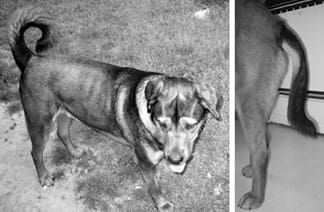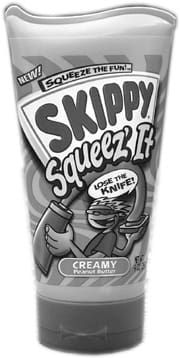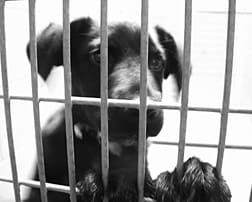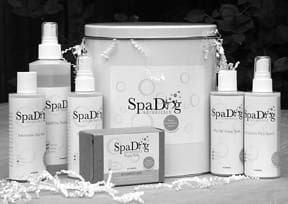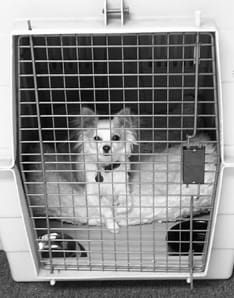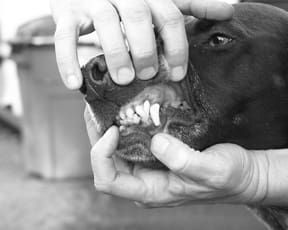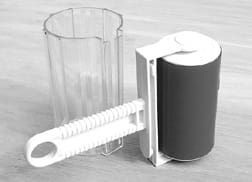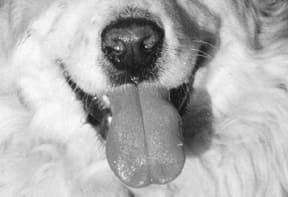SPRAINED TAILS: OVERVIEW
1. Consult your veterinarian if your dog’s tail lies limply or stops wagging in wag-worthy situations.
2. Review the activities that preceded the onset of limber tail, so you can avoid retriggering the condition.
One day last summer, Lucky, my normally exuberant mixed-breed dog, returned with my husband from an off-leash hike exhibiting little of her boundless energy. She made a beeline for her bed, so we joked that she was out of condition; she’d had knee surgery six months earlier and we assumed she hadn’t fully regained her stamina.
But as the hours ticked by and she continued to show little interest in moving, we got concerned. She changed positions very gingerly and seemed to have a hard time sitting and lying down. Worse, we couldn’t even coax a single happy tail thump from a dog who usually wielded that appendage with abandon. She looked at us with sad eyes and drooping ears, telegraphing that something wasn’t right.
I started worrying about all the possible things that could have happened. Did she eat something foul on the trail? Had she re-injured her knee? She was eating and drinking, and her temperature was normal, but clearly this was not a healthy animal. An emergency examination was in order.
Our veterinarian examined her from stem to stern, and it was in that latter area she spotted the problem. “I think she has a sprained tail,” she opined. “It should heal on its own within a week, but if she seems really tender, you can give her an anti-inflammatory.”
Sure enough, within four days Lucky’s drooping and strangely silent tail regained both its loft and its wag. Still, I was surprised that in the years I’ve written about dogs I’d never heard of a sprained tail. It turns out that the malady is well known among trainers and handlers of certain dog breeds, and while “sprain” is something of a misnomer, the affliction has a formal name: limber tail syndrome.
The Limber Tail Checklist
You might suspect your dog has limber tail syndrome if:
■ The tail is somewhat or completely limp.
■ Your dog has difficulty sitting or standing.
■ There was no obvious injury (i.e., a slamming door or an errant foot) to the tail.
■ It occurs soon after extreme activity, prolonged transport, a swim in cold water, or a sudden climate change.
■ His vital signs are good and he’s still eating and drinking normally, despite the floppy tail.
■ The tail shows gradual improvement over a few days. To view a video of a dog with limber tail, see Youtube.
A Tail That Doesn’t Wag
The syndrome seems to be caused by muscle injury possibly brought on by overexertion, says Janet Steiss, DVM, PhD, PT. Steiss is an associate professor at Auburn University’s College of Veterinary Medicine and coauthor of the 1999 study on limber tail that pinpointed the nature of the muscle damage. Researchers used electromyography (EMG), imaging, and tissue testing on dogs affected with limber tail and concluded that the coccygeal muscles near the base of the tail had sustained damage.
The muscle injury of limber tail is characterized by a markedly limp tail, which can manifest in several different ways.
“You can see varying degrees of severity,” says Dr. Steiss. “The tail can be mildly affected, with the dog holding the tail below horizontal, or severely affected, hanging straight down and looking like a wet noodle, or anything in between.”
In some dogs, the tail may stick out a couple of inches before drooping; others may exhibit raised hair near the base of the tail as a result of swelling. Depending on the severity of the injury and the dog’s tolerance to pain, some animals – like Lucky – may have difficulty sitting or lying down. And many dogs reduce or eliminate wagging entirely, probably due to soreness.
Limber tail can occur in any dog with an undocked tail, but certain breeds, especially pointing and retrieving dogs, seem particularly susceptible to it. Among these breeds are Labrador, Golden, and Flat-Coated Retrievers; English Pointers and Setters; Beagles; and Foxhounds. Both sexes and all ages can be affected. Other common names for the condition are “cold tail” (especially among Retrievers, who often exhibit symptoms after swimming in frigid water), “limp tail,” “rudder tail,” “broken tail,” or even “dead tail.”
The condition resolves over the course of a few days or a week and usually leaves no aftereffects. According to Dr. Steiss, there is anecdotal evidence that administering anti-inflammatory drugs early in the onset can help shorten the duration of the episode, but no veterinary studies have yet confirmed this.
The exact cause is unknown, but according to Dr. Steiss, there are a few different factors that seem to be linked to limber tail. Overexertion seems to be a common precursor, especially if an animal is thrown into excessive exercise when he or she is not in good condition (as in Lucky’s case).
“For example, if hunting dogs have been sitting around all summer and then in the fall, the owner takes them out for a full (weekend of hunting), by Sunday night suddenly a dog may show signs of limber tail,” she says. “The dog otherwise is healthy but has been exercising to the point where those tail muscles get overworked.”
Another risk factor is prolonged confinement, such as dogs being transported in crates over long distances. If competition dogs are driven overnight to a field trial and don’t have a few breaks outside the crate while they’re on the road, says Dr. Steiss, they may arrive at their destination with limber tail.
Uncomfortable climate, such as cold and wet weather, or exposure to cold water may also trigger limber tail. Retrievers seem particularly prone to exhibiting symptoms after a swimming workout, and some, says Dr. Steiss, are so sensitive to temperature that they show signs of limber tail after being bathed in cold water.
Limber Tail Syndrome: A Tricky Diagnosis
For an owner, the sight of a normally active tail hanging lifelessly can be alarming. After all, dogs’ tails are barometers of both mood and health, and a tail carried low and motionless could indicate anything from nervousness to serious illness. Limber tail syndrome has been around for a long time, but it isn’t very common and many veterinarians – especially those who don’t work regularly with hunting or retrieving dogs – aren’t familiar with it. Consequently, a variety of diagnoses can be given.
Limber tail can be mistaken for an indication of a disorder of the prostate gland or anal glands; a caudal spine injury; a broken tail; or even spinal cord disease. The all-purpose phrase “sprained tail” might also be used.
Ben Character, DVM, a consulting veterinarian in Eutaw, Alabama, and a member of the American Canine Sports Medicine Association, specializes in sporting dogs. He’s seen plenty of cases of limber tail but doesn’t call it a sprain.
“Sprain is a bad word for it because a sprain indicates a joint and problems with the ligaments surrounding a joint,” Dr. Character explains. “As far as we know, this is all muscular.”
” ‘Sprained tail’ is kind of a catchall, non-specific phrase that simply means something’s wrong with the tail,” agrees Dr. Steiss. “The tail has all kinds of joints because it has many tiny vertebrae, but sprain isn’t the correct term here.”
How can an owner tell if limber tail is the cause of a dog’s discomfort? Look to the circumstances surrounding the onset of the droopy tail, suggests Dr. Steiss, especially if any of the risk factors were present.
“Limber tail has an acute onset. It is not a condition where the tail gets progressively weaker,” she says. “Instead, it is an acute inflammation. Typically, the tail is suddenly limp and the dog may seem to have pain near the base of the tail. Over the next three to four days, the dog slowly recovers to the point where by four to seven days he’s usually back to normal.”
Dr. Character says it’s a tough clinical call to make. “In order to really diagnose limber tail, you’d have to do electromy-opathy (of the tissue) or do radiography to examine the inflammation, and a general practitioner just won’t be able to do that.”
Effects of Limber Tail
While an episode of limber tail can be unsettling for an owner, it doesn’t hamper most dogs’ ability to function normally.
“For your average hunting dog, it probably won’t make a difference,” says Dr. Character. “The tail is involved in balance when they run, but how much that’s going to knock them off their game . . . it may not be enough to notice.”
However, competition dogs can be sidelined: “Athletic dogs competing in field trials will not be able to compete when the tail doesn’t have its normal motion, since the condition will be obvious to the judges,” says Dr. Steiss.
Limber tail doesn’t recur with any regularity among dogs that have already experienced one episode, according to Dr. Steiss: “In the majority of cases it happens once and doesn’t happen again,” she says. “But there are a few dogs where, if put into the same situation, it happens more than once.”
That was the case with Hannah, a Lab/Pit Bull mix owned by Miriam Carr, a dog care specialist in Richmond, California. Carr operates a dog-exercise business, PawTreks, specializing in off-leash outings. Often, Carr’s trips include swimming opportunities for her clients’ dogs. Her own dogs, of course, get to participate in every outing. “Hannah was very active – she went to the park every single day – so she was in great condition,” says Carr.
After Hannah suffered several incidents of limber tail, however, Carr had to limit the dog’s participation in the activities that seemed to trigger the limber tail incidents. “When Hannah swam with other dogs she was more competitive and would swim harder to get to the ball first, and that sort of set off the problem with her tail,” says Carr. “When we finally realized that was the problem, we wouldn’t let her swim with groups of dogs.”
It was smart management on Carr’s part. In rare cases, a dog’s tail can be permanently affected by recurrent episodes, says Dr. Steiss. “A few can injure the muscle so severely that the tail may not be straight again. Probably, there’s been a significant loss of muscle fibers plus scar tissue build-up in the tails in those dogs,” she explains.
What to Do If Your Dog Has Limber Tail
■ Check with your vet to rule out any other possible ailments.
■ Rest your dog.
■ Ask your vet if an anti-inflammatory medication may be appropriate for the first 24 hours. (See “Administer With Care” for more information and warnings about anti-inflammatory use.)
■ Gradually return your dog to activity.
■ Try to determine what factors seemed to cause the limber tail and avoid them in the future.
Do More Dogs Have Limber Tail Now Than in the Past?
Before 1990, limber tail wasn’t often recognized outside hunting- and sporting-dog circles. But in 1994, Auburn University’s College of Veterinary Medicine launched a canine sports-medicine program and researchers (including Dr. Steiss) decided to take a closer look at the tail disorder after talking to owners and trainers in the region.
“These trainers were saying, ‘Hey, this is a problem. We see it frequently, and nobody really knows what it is,'” says Dr. Steiss, who had a special interest in muscle disease and was intrigued by the strange injury. Although it seemed uncommon in the dog population as a whole, it sprang up with regularity among Pointers in the area. In one instance, an Alabama kennel discovered that 10 of its 120 adult English Pointers had been affected with limber tail in one morning.
In 1997, Steiss and her colleagues began an epidemiological study (believed to be the first) of sporting dogs in the southeastern United States. A total of 3,066 dogs were included in the study, two-thirds of which were used for hunting. The survey yielded information about the characteristics of limber tail in 83 dogs. The publication of the study results made more vets aware of the syndrome, so it’s not clear whether the perceived rise in the number of limber-tail cases is due to improved diagnosis or an actual increase in occurrence.
“It’s definitely being recognized more often, (but) we hope it is happening less frequently in sporting dogs as trainers become aware of the specific risk factors,” says Dr. Steiss, who is also entertaining another explanation for the increased frequency. “One thought I had is that in recent years more people are being becoming physically active and they may want to include their dogs in jogging, hiking, and other strenuous activities. It is possible that we may see more dogs coming down with this disorder, or other athletic-related disorders, simply because they’re participating in more physical activities with their owners.”
Life for Dogs After Limber Tail Syndrome
According to Dr. Steiss, researchers don’t believe there’s any underlying pathology to the muscles in afflicted dogs, nor is there any suggestion that a propensity for limber tail is genetic. As noted, while some breeds may be more prone to it – most likely due to their higher activity levels – any dog with a full tail is susceptible.
If your dog develops limber tail, treatment should include at least a few days of rest. Depending on the advice of your veterinarian, you may also administer an anti-inflammatory in the first 24 hours, under the direction of a vet. There is no evidence that anti-inflammatories speed healing, but some owners say they’ve noticed faster improvement when the medications are part of the mix.
Owners should also consider what activities their dogs were engaged in prior to the onset of the condition. Limber tail will show up quite soon after the triggering event, usually within hours or overnight. If you can isolate what it was that brought on the condition, whether it was a over-long off-leash hike or a swim in cold water, you can avoid repeating the situation.
Finally, ease your dog into any intense activity to slowly improve his condition. Many cases occur when a dog is a couch potato in the off-season and then plunges back into hunting or training full time.
As for Lucky, we haven’t seen a recurrence, but we also committed ourselves to gradually increasing her activity until her physical strength matched the demands of her workouts. Her tail is once again thumping away at full speed – and we aim to keep it that way.
Freelance writer C.C. Holland, of Oakland, CA, is a frequent contributor to Whole Dog Journal.


